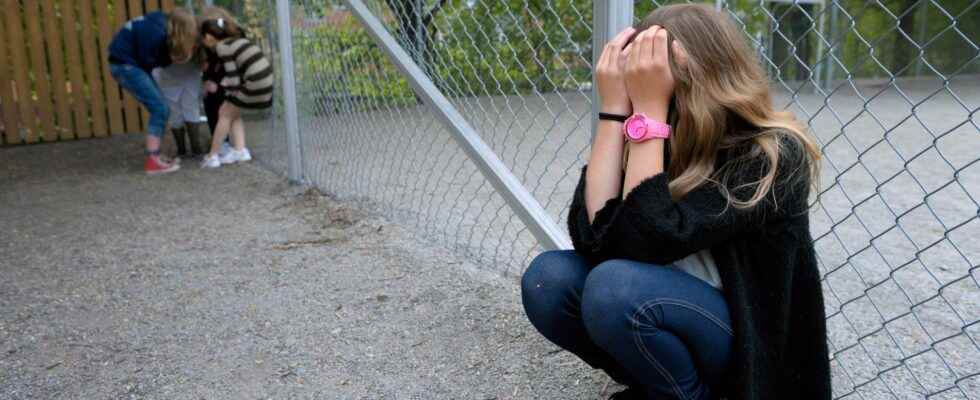full screen
Next
Bullying among young people is increasing and most of all at school. The picture is arranged.
1 of 2Photo: Janerik Henriksson / TT
Bullying among young people of school age has increased sharply in recent years. A recent survey shows that the equivalent of three students in each class are bullied repeatedly.
In recent months, 140,000 children have been bullied at school and online more often than on one or two occasions, according to the survey. In 2015, the corresponding number was 60,000.
Another way of understanding the increase is that the proportion who are exposed so often has gone from one or two children in each class to three.
– The proportion of children who have been bullied has doubled in ten years, states Magnus Loftsson, research leader at the organization Friends, which works against bullying.
Verbal insults most common
Friends has commissioned the measurement company Novus, in collaboration with researchers from Örebro University, to carry out a web study in which young people aged 9–18 have been asked questions about bullying.
Here it appears that 110,000 cases of bullying take place in schools, 60,000 in internet environments and that 30,000 in environments where schools and the Internet overlap.
The most common are verbal insults, ie young people being exposed to shitty comments and being ignored or frozen out – something that also happens on the internet. The second most common are physical violations, having been beaten, kicked, pushed, held or threatened.
– I think it’s terrible, I get angry, says Magnus Loftsson and continues:
– I have sat and stared at these numbers no matter how much. Sweden has been a pioneering country in that we have had a very low incidence of bullying, and we are no longer.
Past trends
Indications that bullying has become a growing problem over the years can also be seen in other surveys. The Swedish Public Health Agency and the Swedish Media Council have in various surveys captured the trends over the past 15 years.
The Swedish Schools Inspectorate regularly conducts a large survey among school children, measuring, among other things, perceived security in the school environment.
In 2010, nine out of ten students in year 9 stated that they felt safe at school. In the 2020 survey, that proportion had dropped to eight out of ten.
– Lack of security is often what precedes a violation, says Mårten Petersson, children and student representative at the Swedish Schools Inspectorate.
According to him, there are also shortcomings in how some schools handle violations.
– You do not act fast enough, you do not always take it seriously. There needs to be a structured approach that prevents violations from being repeated, but that work process is not available to all principals.
“Bullying Commission”
Magnus Loftsson points out that even though many schools are good at dealing with individual cases of bullying and getting them to stop, there is often no plan to counteract bullying.
– The fact that many new children are constantly exposed, the school does not succeed in preventing.
In the autumn, the government has proposed amendments to the Education Act that aim to increase security and study peace in schools. Among other things, school staff will be allowed to intervene physically in the event of violence, be able to more easily suspend and relocate students and introduce stricter rules for mobile phone use in schools.
But Magnus Loftsson believes that a national overall strategy is required for how bullying should be handled in Swedish schools and that the government should appoint a bullying commission to set out how such a policy should be formulated.
– If we look at our neighboring countries, Norway and Finland, there is a much more conscious work. Denmark has also reduced bullying, and they have been at higher levels than we have in Sweden, he says and adds:
– We have never had such a high proportion of children exposed to bullying – both at school and online – as we have today. The development is going in the completely wrong direction, says Magnus Loftsson.
Facts
About the survey
12,000 parents were invited to have their child participate in the bullying survey. As a result, in March, 1,657 children, aged between 9 and 18 who go to school, answered questions about bullying. The response rate corresponds to about 14 percent.
The method means that the response rate is lower than in surveys with adult respondents, which is normally around 60 percent. When the respondents are children, the response rate drops to about 15 percent. In this case, the response rate is thus slightly lower than normal.
The method enables a nationally representative selection of children. Any distortions in the sample have been weighted using known population figures for children in terms of gender and age. The survey is judged to be representative of the country.
How bullying is defined:
Intentionality – the act is performed with the intention of harming.
2. Imbalance of power – the person who is exposed is at a disadvantage of some kind, it can be about several against one or about uneven power relations.
Repetition – the violations occur repeatedly over time, it should be more frequent than twice in the last two months.
Source: Friends – The report “Incidence of bullying: Three children exposed in each class”
Read more
